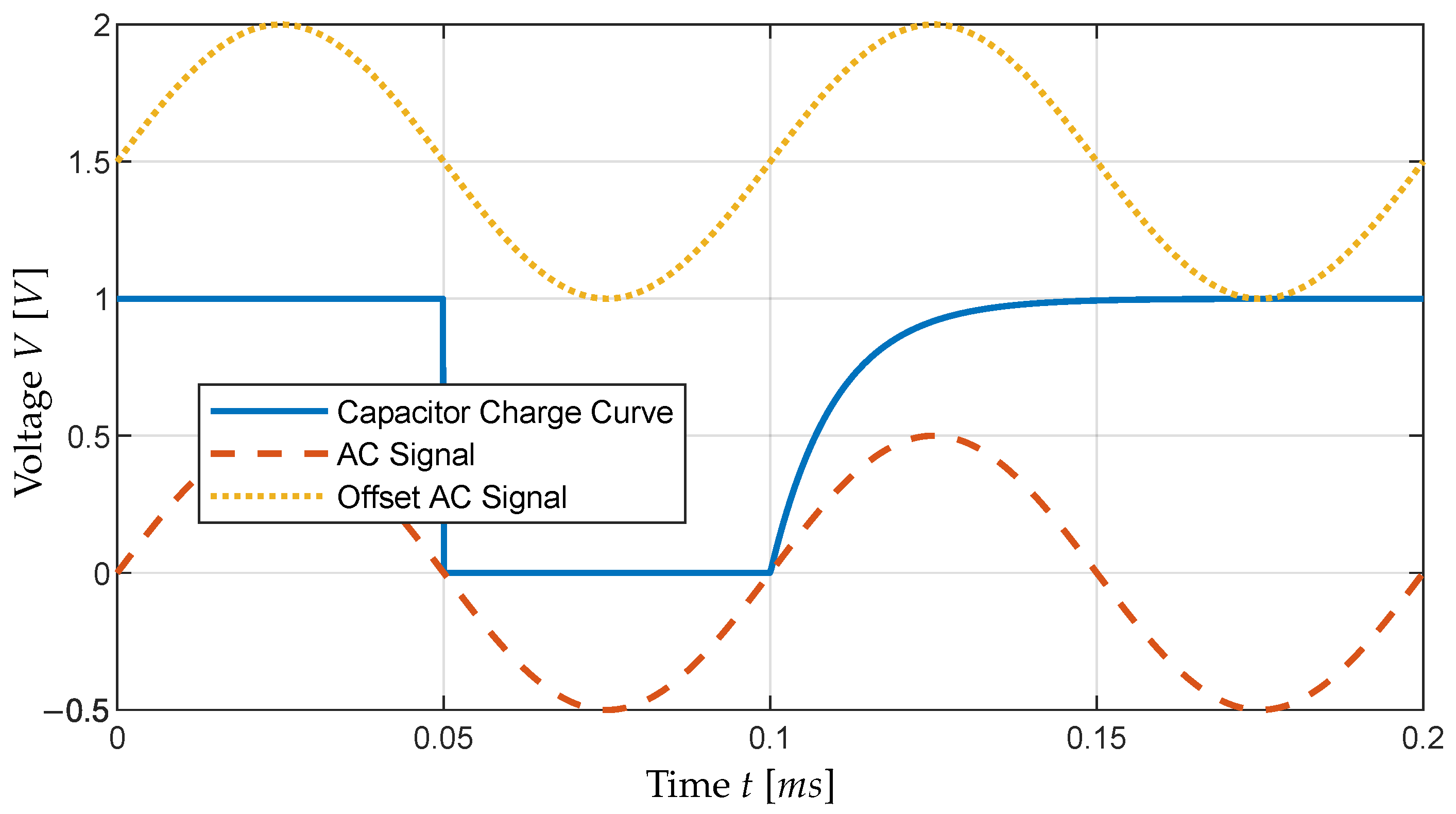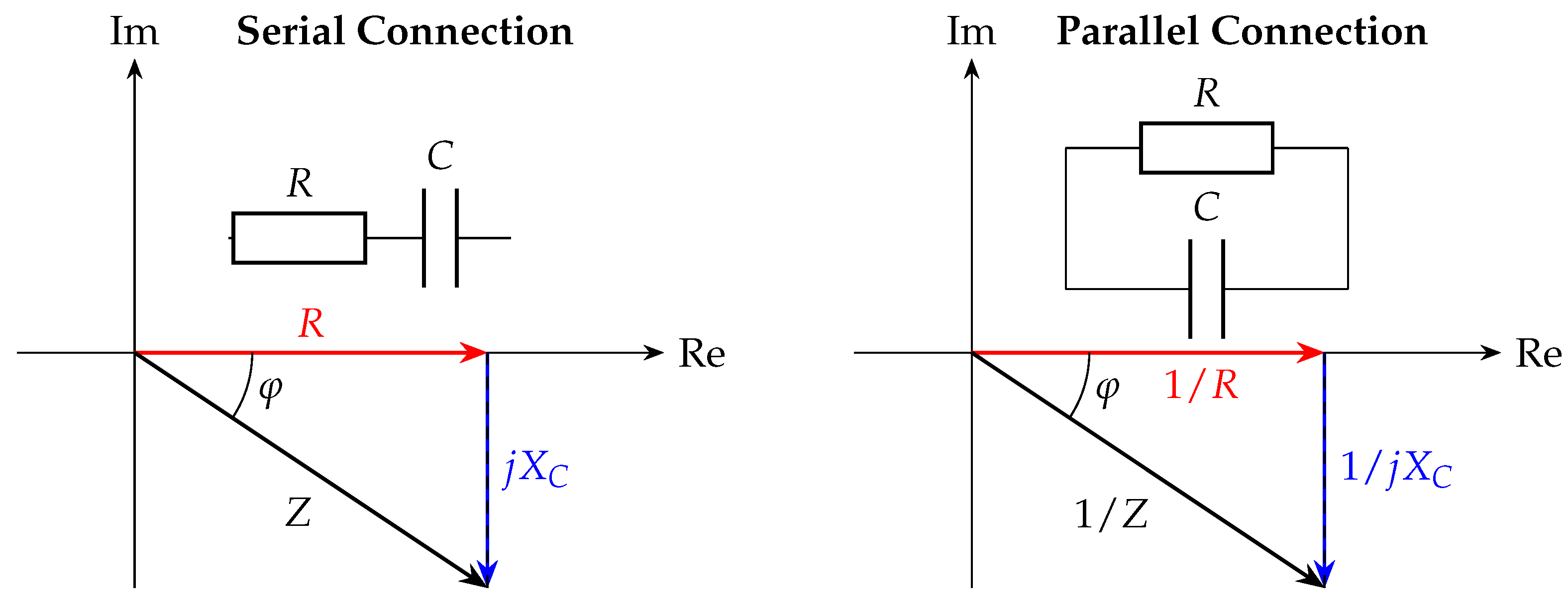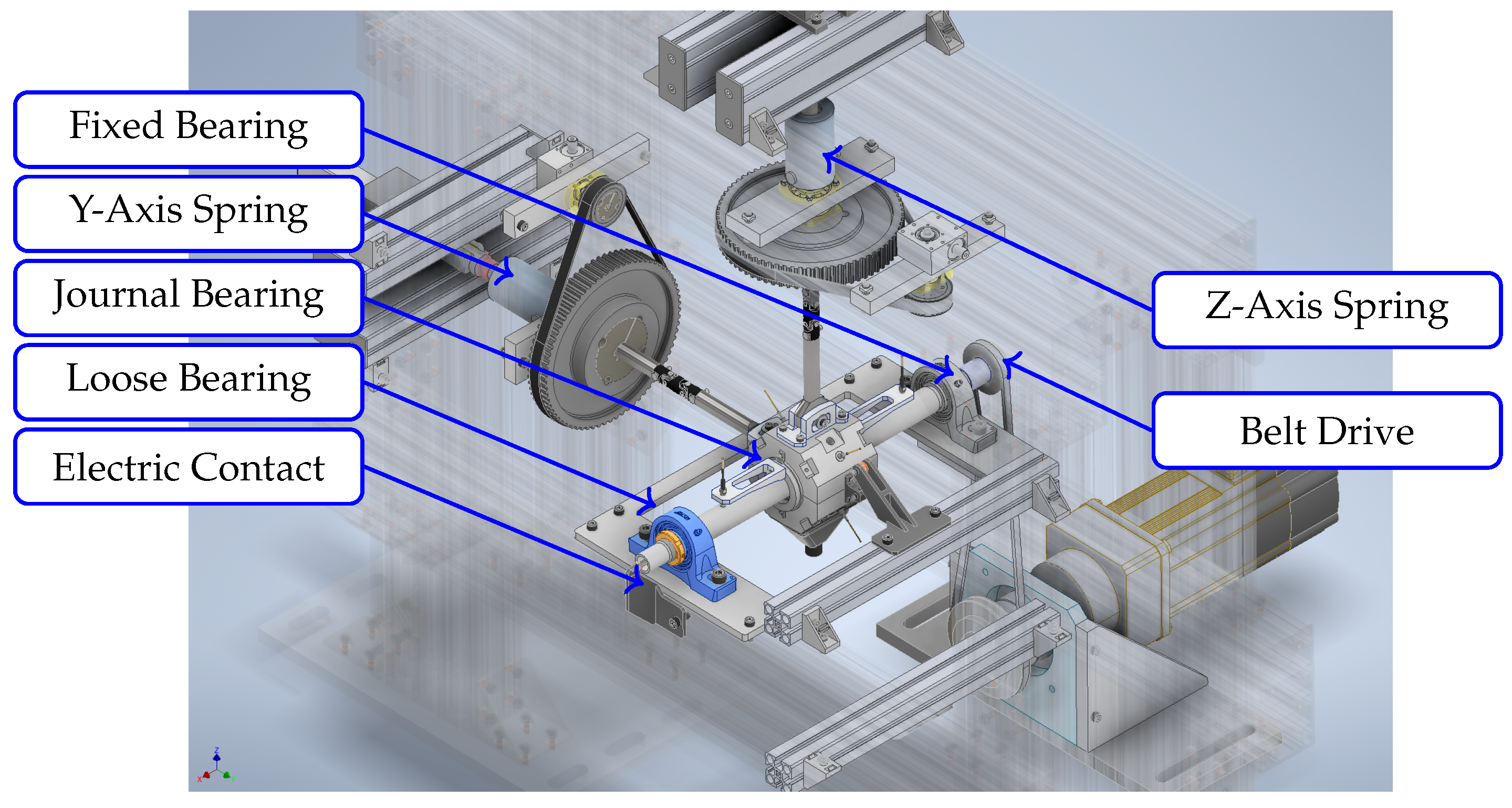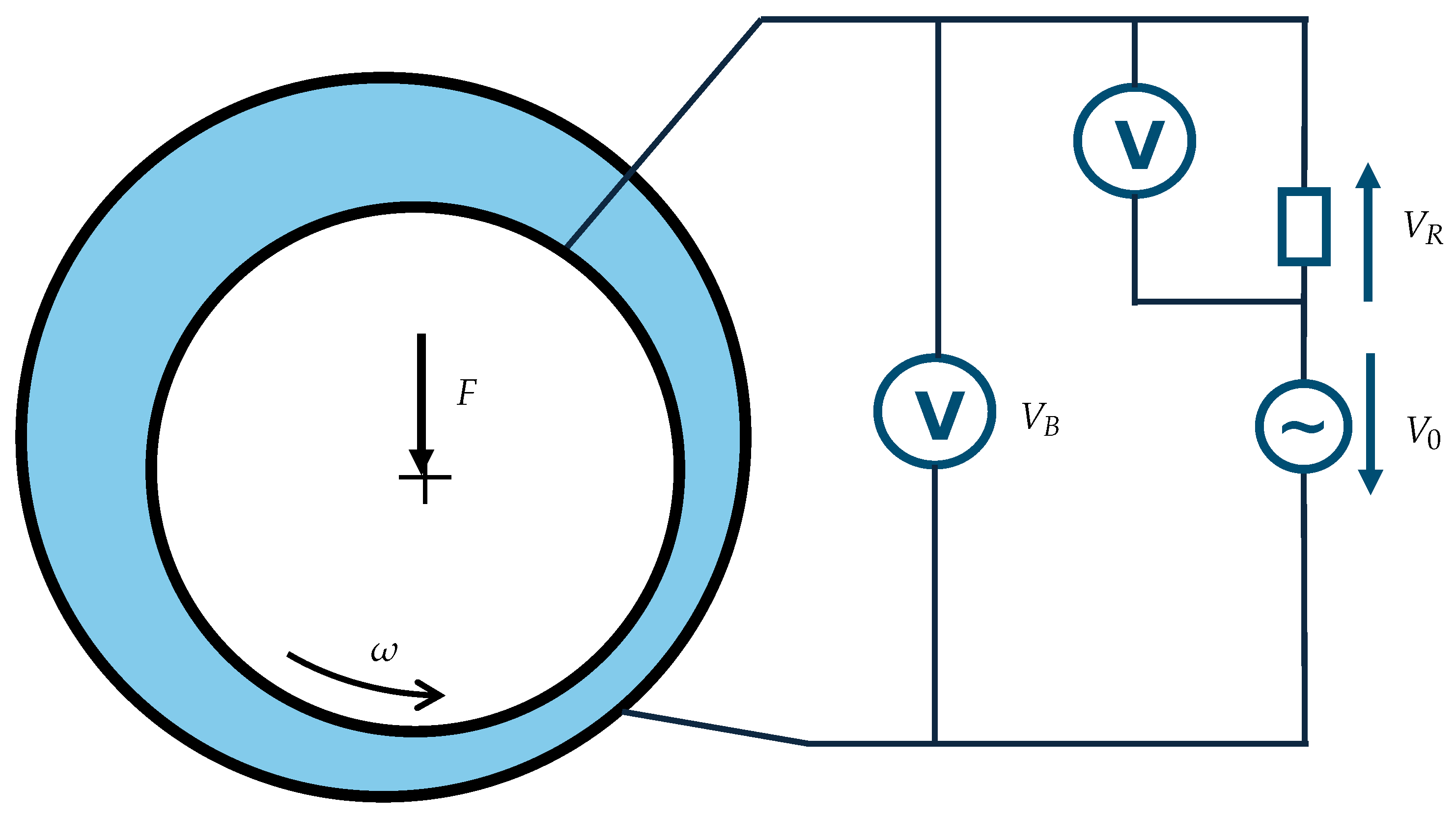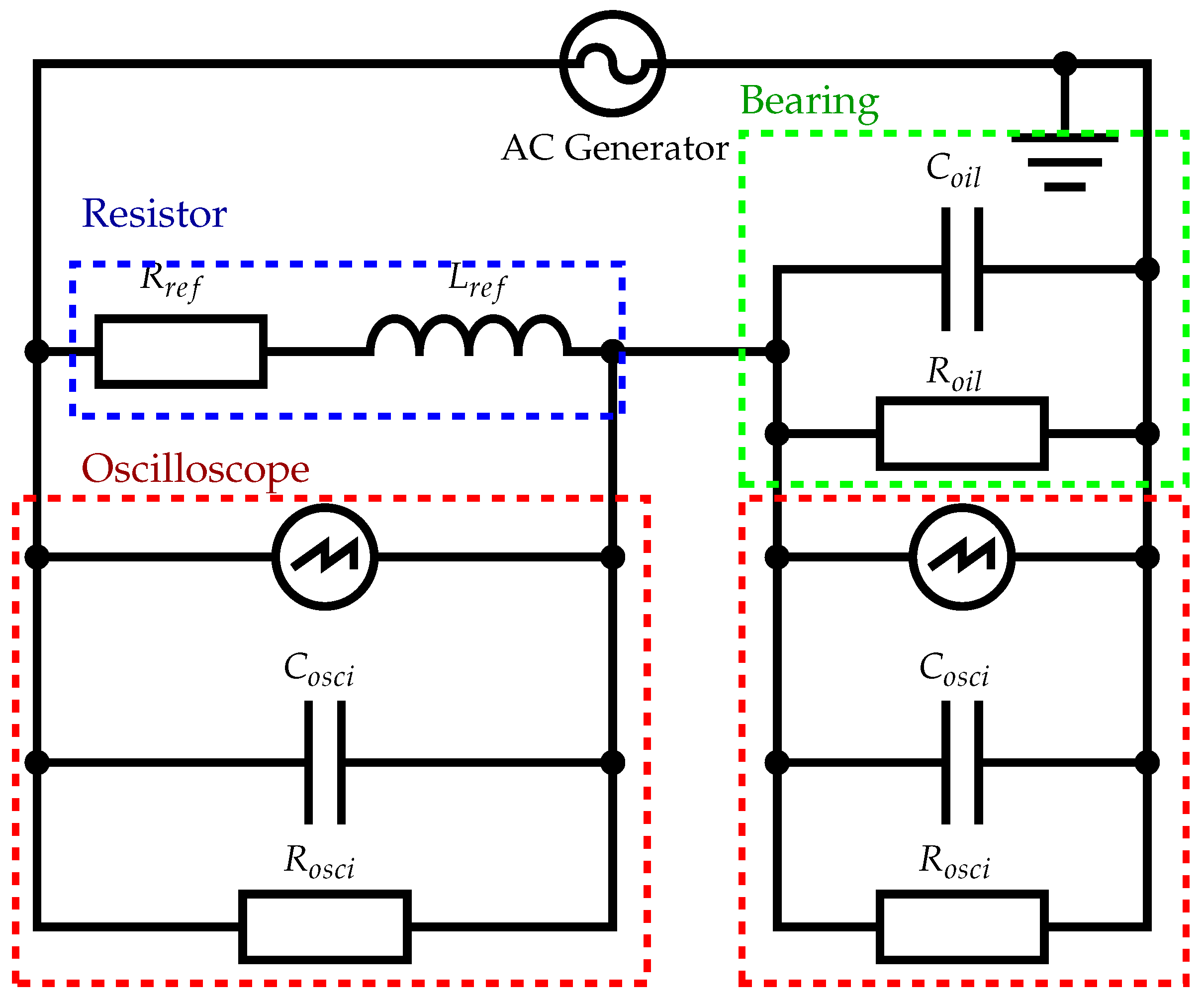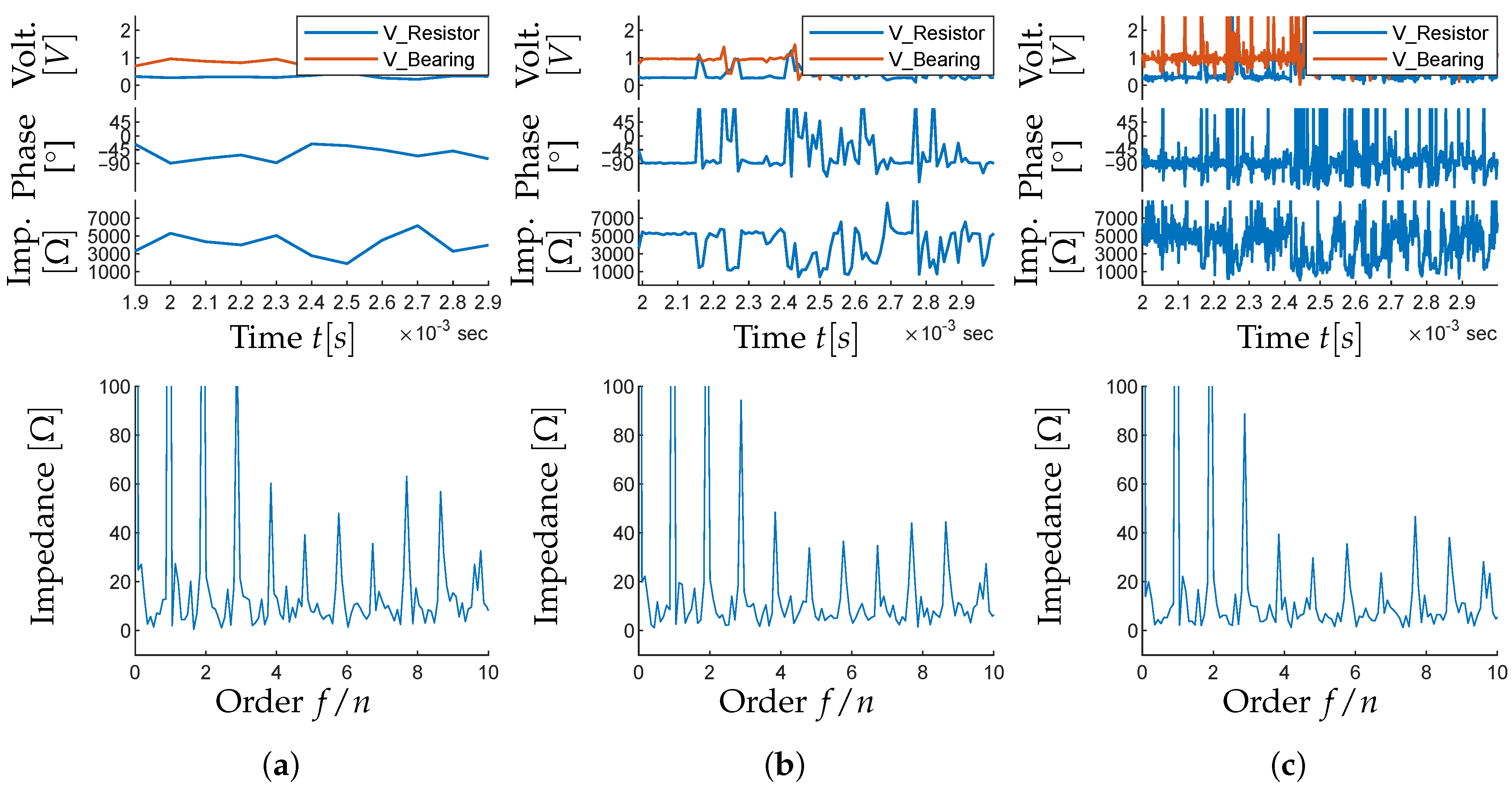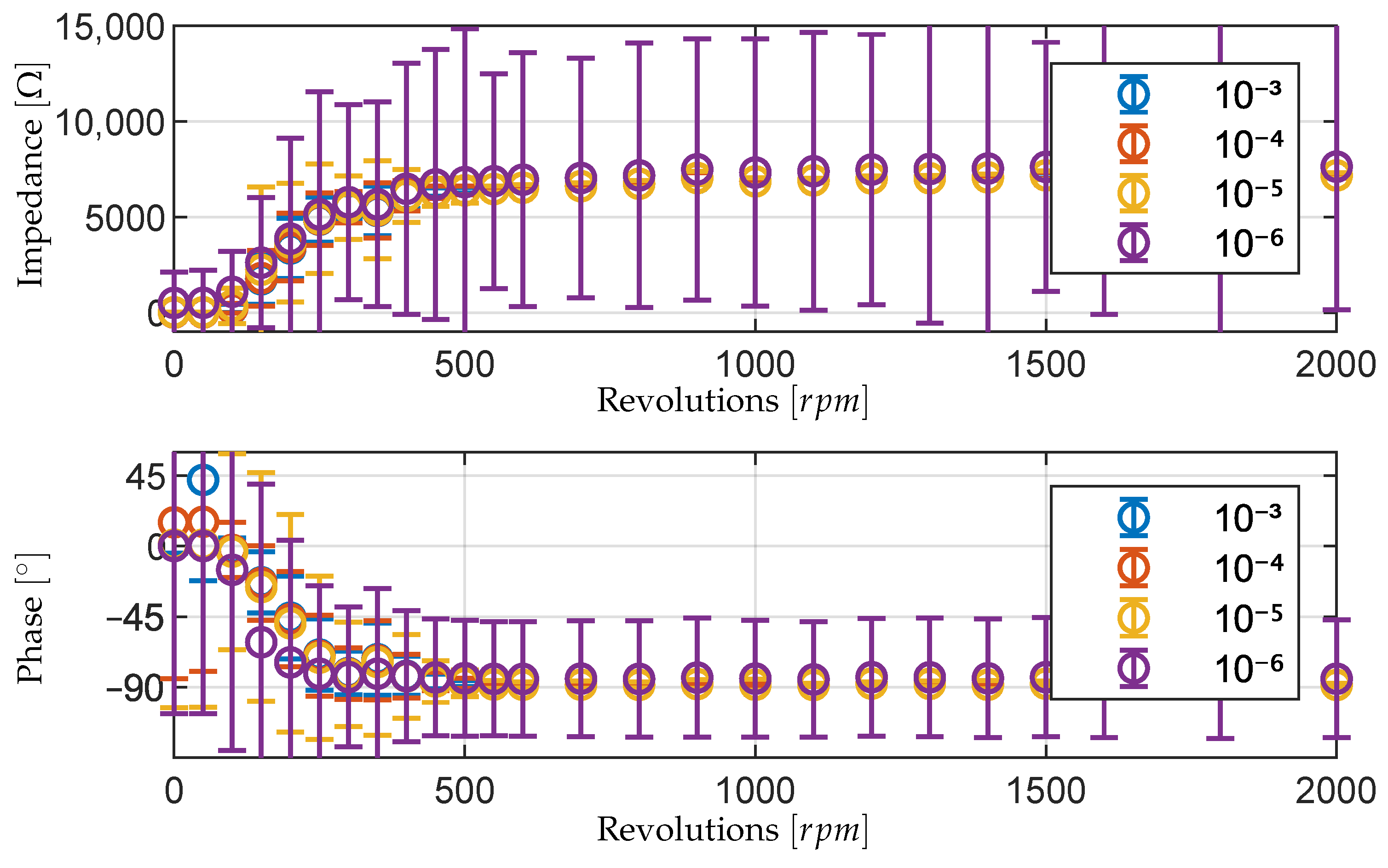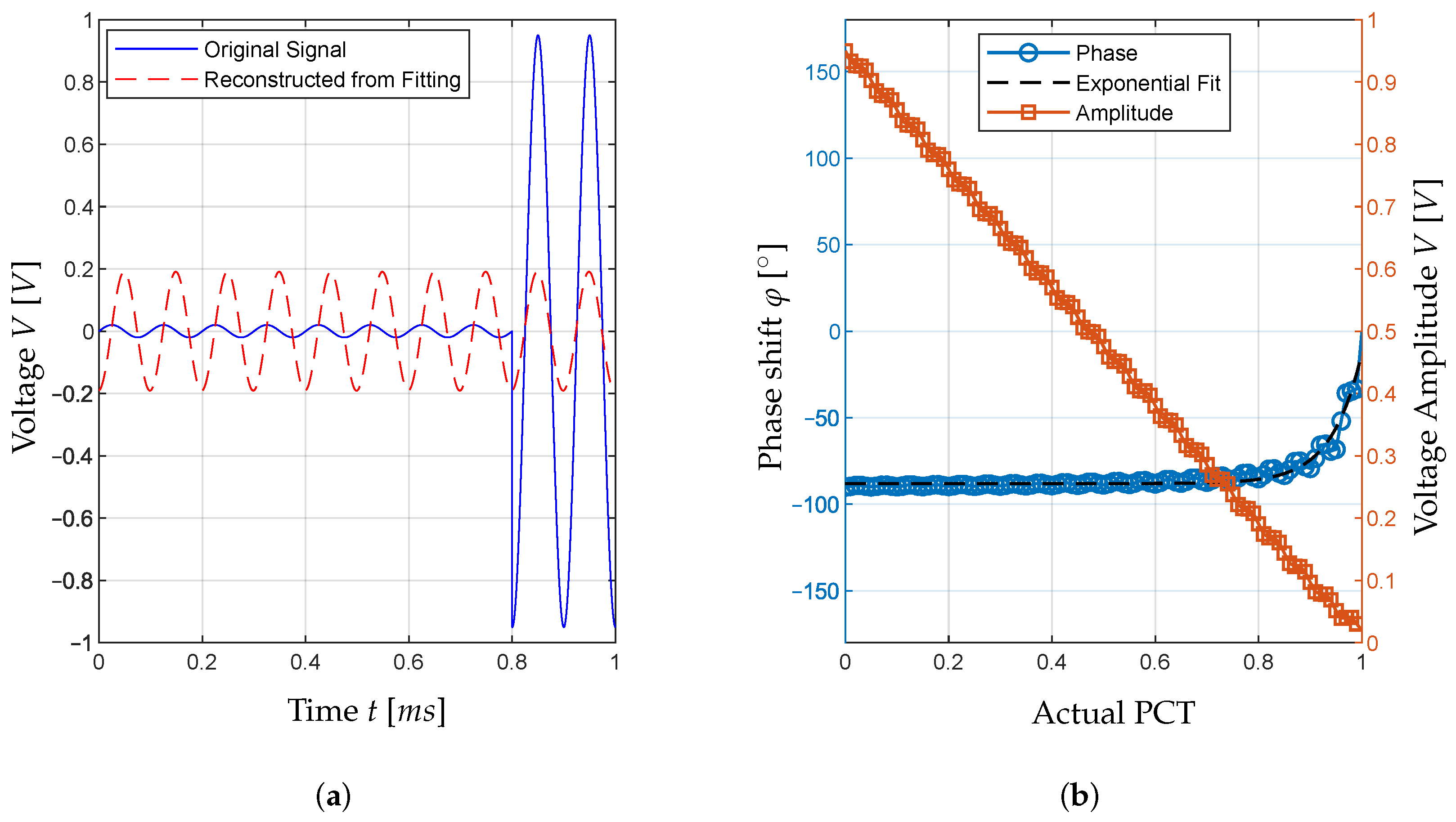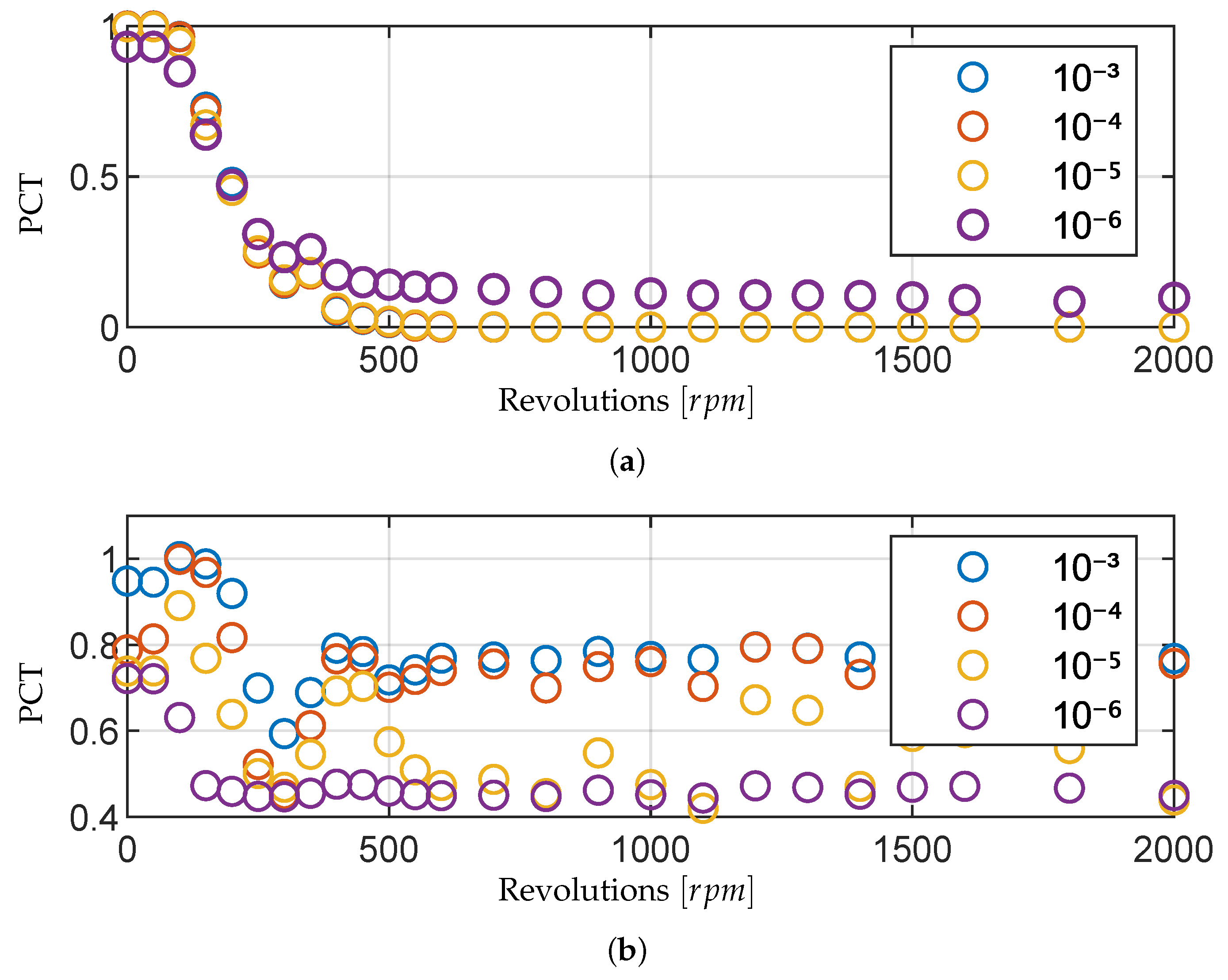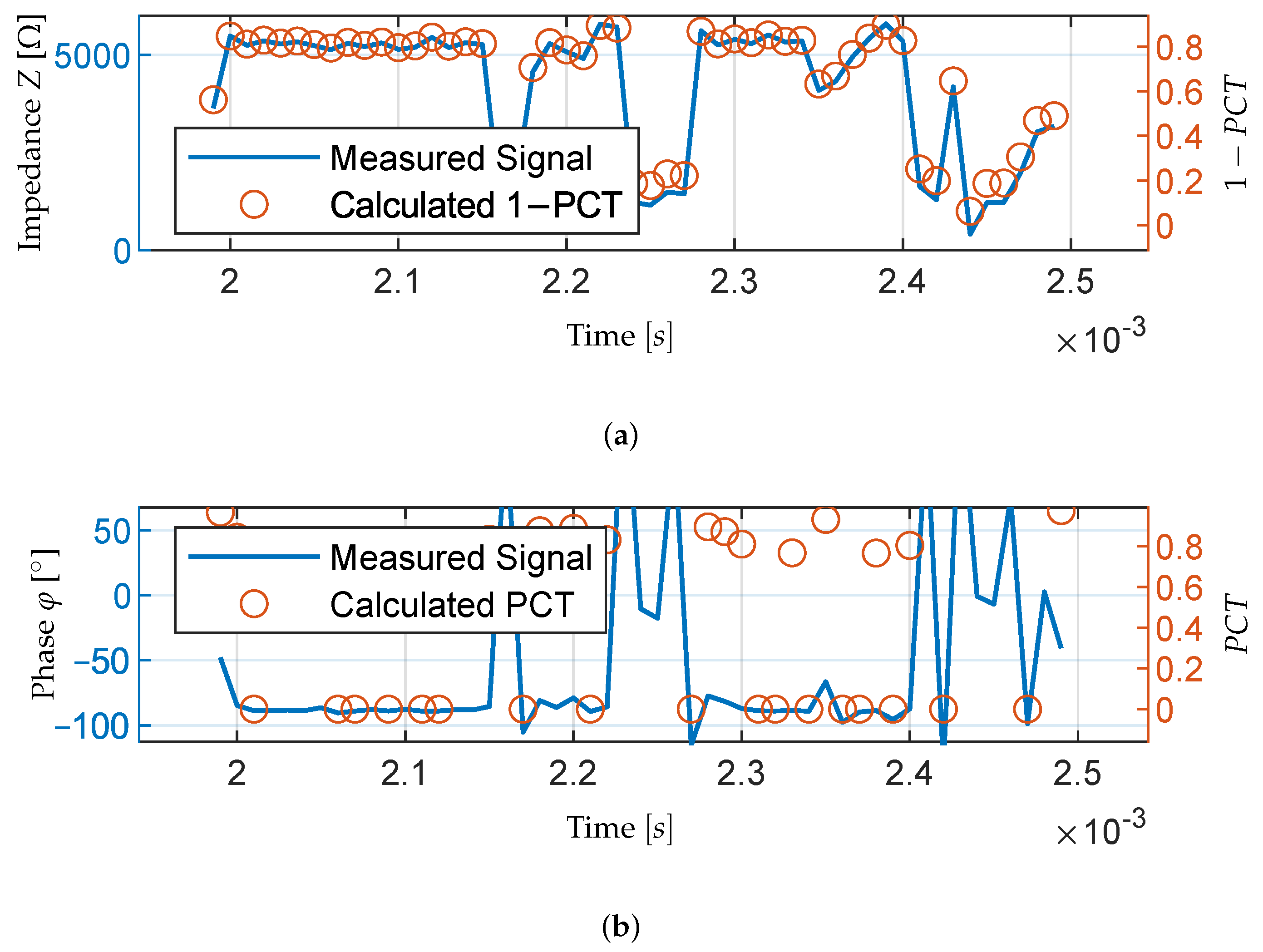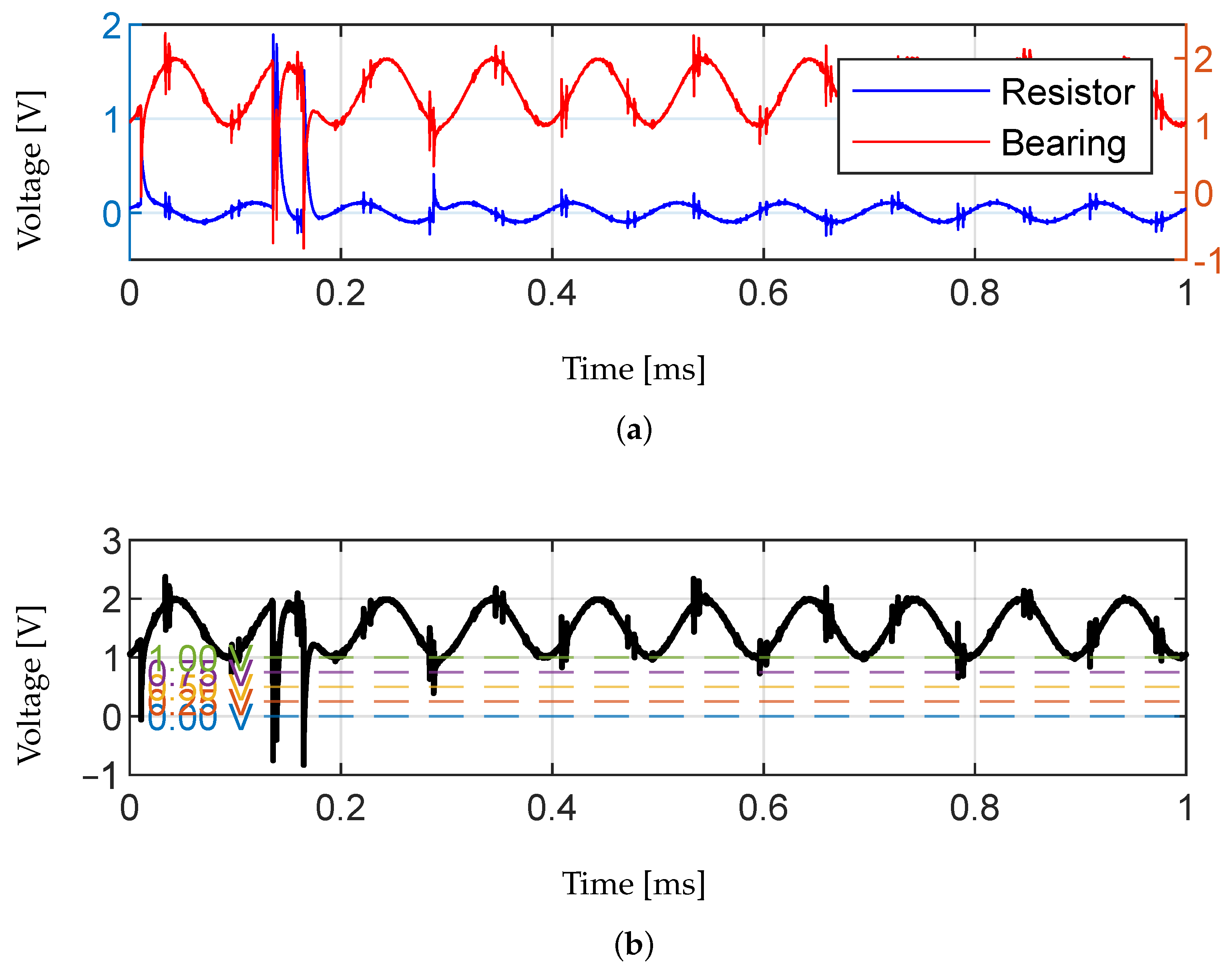In the following section, the answers to the initial research questions will be given. The first section focuses on the measurement setup and a signal type according to RQ1. The setup is then chosen as a prerequisite to discuss the following research questions of the data analysis method (RQ2) and how to improve the data analysis method to allow for a more accurate interpretation of the results obtained (RQ3).
3.1. Measurement Setup and Signal Type
As discussed in
Section 2, the capacitive behavior of bearings can generally be measured using DC voltage signals and AC voltage signals. When DC voltages are applied, the charging curve can be measured and the capacitance calculated through Equation (
1).
For that measurement setup, it is necessary to ensure a constant capacitance for the duration of
. However, this cannot be assumed for tribological systems as individual metallic contacts may occur during this time frame. Additionally, small changes in lubrication film thickness can cause significant changes in capacitance [
6], thus reducing the accuracy of this approach.
In practice, this means that the automated analysis of these measurements has to recognize the initiation of a charging curve (e.g., immediately after a metallic contact has occurred). The determination of the exact point in time is difficult as background noise will affect the measured signal, leading to erroneous readings. After the determination of this point, the algorithm has to measure the time until of the charge is reached and ensure that no additional metallic contact occurs during this time. If there is additional metallic contact, the measured time has to be reset and start again. For a human operator, the analysis of a single metallic contact and measurement of is easy; however, the automation of such an algorithm is more complex in systems with transient behavior.
One advantage of the DC measurement is the simple observation of individual metallic contacts, as performed by Hemskeerk et al. [
21] and described in
Section 2.5.3. This approach only allows the detection of metallic contacts in mixed lubrication but it does not allow a measurement of the lubrication film thickness. However, it is beneficial to measure the lubrication film thickness because this information can be used to determine how much additional load the bearing can support before operating in potentially harmful mixed lubrication. Therefore, for practical purposes, the DC signal is not considered further for the measurement of the electric behavior of journal bearings.
When using AC signals, a simple PCT analysis cannot easily be made as these signals reach 0 V at least twice per period. An automated analysis of contact times is therefore difficult. They also require additional signal analysis methods, as discussed in
Section 2.5. However, the advantage of these signal is the long duration which means that periodically repeating dynamic effects (e.g., the roundness deviations of a shaft) can be compensated by averaging the measurement. Therefore, this signal can be considered to be more robust and automated analysis is possible, as will be discussed in
Section 3.2.
One last signal type that in theory offers the benefits of both signals is an offset AC signal, as depicted for visualization in
Figure 2. In this signal, the AC signal is superimposed with a constant DC signal. If the DC part of the offset signal is sufficiently high, the signal no longer reaches 0 V unless metallic contacts occur. Therefore, the individual contacts can be identified by an algorithm and the data analysis methods mentioned in
Section 2.5 can still be used. The choice between an AC signal and an offset AC signal is discussed further in
Section 3.3.
When using AC signals or offset AC signals, a voltage divider-based setup or an AC measurement bridge are both possible measurement setups, as discussed in
Section 2.4. The main advantage of the measurement bridge is its robustness against environmental factors such as temperature deviations and the influence of electric fields [
3]. Setups based on a voltage divider, however, can easily be modified and adapted to changes in bearing impedance. For the best accuracy, the reference resistance needs to be within the range of magnitudes of the bearing impedance [
16]. Since the test bench for this contribution is placed within a controlled environment, the simpler voltage divider setup is used as this setup can be more easily adapted to the fluctuating bearing impedance in different lubrication conditions [
3].
3.2. Data Analysis Method
In general, FFT and linear regressions can be used to extract phase and amplitude from a sine signal. In the context of this contribution, the FFT is used as a filtering mechanism to identify known signal frequency from voltage signals. Since the FFT is then no longer a superposition of multiple sine signals but only one sine signal, the FFT and the linear regression yield the same calculation result apart from numerical errors with relative errors between both algorithms of . Even artificially introduced random noise influences the calculation results of both algorithms equally.
This is the case as long as the FFT calculation is not affected by the fence effect described in
Section 2.5.1. The fence effect plays a role if the signal frequency does not match with one of the entries of the frequency vector. An extreme case would be if the signal frequency remains at 10 kHz and the length of a time window is at
s. In that case, the FFT analysis calculates a sine signal at 100 kHz with an amplitude of 0 V as there is no sine signal at 100 kHz which can reproduce the actual signal frequency of 10 kHz. In this case, the linear regression can still extract an amplitude and a phase as long as there is a sufficient number of data points in a time window.
In order to investigate the influence of the window size on the measurement analysis,
Figure 7 shows identical measurements taken at 1000 N and 1000 rpm with window sizes between
s and
s. The analysis is performed using a linear regression algorithm as the FFT analysis can only yield window sizes of up to
s, as described in
Section 2.5.1.
Figure 7a shows the first measurement at a window size of
s. That means for each
s, the measurement results are fed into a linear regression algorithm that fits the amplitude and the phase of a sine signal to the measurement results. The resulting sine functions describe the two voltages
and
from which the phase and the impedance are calculated. Therefore, each window yields exactly one value for phase and one value for impedance. For the plots in
Figure 7, the time is plotted between 1.9 ms and 2.9 ms, which is kept constant for each of the subfigures. In subfigure (a), that means only ten measurement values are available for the phase and impedance plots. At 200 rpm, mixed lubrication is expected. However, within the selected time interval, the phase does not reach
as would be expected during temporary metallic contact. This is because the contacts captured within this time frame are shorter than one window.
This becomes apparent in
Figure 7b, in which the window size is reduced to
s. Now individual contacts are visible more clearly in the phase and impedance signal. One example is seen between
ms and
ms, which shows a period of metallic contact that can be identified by a reduction in impedance and an increase in phase towards
. It should be noted that the phase angle reaches positive values; however, that is the result of measurement inaccuracies at low impedances. A more realistic interpretation of the phase angle would be
. In subfigure (a), this contact is not noticeable, as one time window ranges from
ms to
ms and the contact is relatively short compared to the rest of the window at hydrodynamic lubrication. The contact only slightly increases the phase for the data point at
ms in subfigure (a). Therefore, it can be said that larger window sizes act as a summarizing factor in which individual contacts are not noticeable within an analysis window.
Figure 7c shows the reduction of the window size to a more extreme case at
s. With the measurement frequency of 10 MHz, this means that each window only contains ten measurement points which are used for the regression algorithm. Consequently, the time resolution of the analysis is further improved and even shorter contacts are potentially still visible. However, that also means that inaccuracies play a more significant role as it is questionable how accurate a regression algorithm can be with only ten available measurement points with noise effects from the environment. This could be improved by increasing the measurement frequency but that also increases the size of the measurement data further. The noisy signal of subfigure (c) is not only the result of inaccuracies. Metallic contacts cause low impedance values, which create calculation inaccuracies and result in non-physical phase angles. Some of the noise in
Figure 7c could be due to the fact that window sizes are small enough that individual contacts last for the full window length and consequently create non-physical phase angles and inaccurate impedance values. This can only be falsified with an increase in measurement frequency beyond 10 MHz.
Figure 8 shows the summary of different time window sizes over the rpm range of the measurements by analyzing the measurements for each rpm step, calculating the mean and the standard deviation and plotting them as an errorbar plot. While all measurements generally show the same behavior, as would be expected, it is noticeable that the window size of
s causes a significant increase in standard deviation. Based on these results, the window size of
s seems to represent the best compromise between the detection of individual metallic contacts and reliability of the measurement. Since the FFT analysis can only reach window sizes of
s, the regression algorithm is to be preferred.
One tool for monitoring the amount of metallic contact when using impedance measurement is the PCT value (see
Section 2.5.3). PCT analysis can be used in conjunction with the analysis described in this section to gain information about the ratio of metallic contact. However, as described by Hausmann et al. [
5], PCT analysis is ambiguous and would require small window sizes to be accurate. For that reason, the next section discusses how the interpretation of the measurement results can be improved when mainly using PCT as a concept.
3.3. Physical Interpretation of Analyzed Data Using PCT Analysis
In this section, firstly, adaptations to the analysis methods are presented which allow an improvement to the precision of the PCT analysis when using AC signals in transient system behavior such as when changing from metallic contact to hydrodynamic lubrication temporarily. Secondly, the interpretation of an offset AC signal is performed to compare the suitability of AC signals and offset AC signals when measuring the electric behavior of journal bearings.
3.3.1. Behavior of PCT Analysis in Transient Systems
As described in
Section 2.5.3, Hausmann et al. introduced a way to estimate the PCT value based on the phase angle and Equation (
11) [
5]. However, it is not known whether a linear estimation of the PCT value based on the phase angle represents an approximation of the actual PCT value. Therefore, a test is set up that simulates different PCT values of signals. For that purpose, a sine signal represented by
Figure 9a is setup in MATLAB R2025b. The signal lasts for the length of one time window, as it would when FFT or regression analysis is used. The sine signal is described by Equation (
7), with a peak value of
V for hydrodynamic lubrication and
V for boundary lubrication. The values are taken from measurements at the test bench to ensure that the simulated signal is representative. It is further assumed that the phase of the signal during hydrodynamic lubrication is shifted by
compared to the phase during boundary lubrication. The resulting signal can be written according to Equation (
12). In this case, a PCT value of
is assumed with metallic contact at first and hydrodynamic lubrication in the final
ms.
This signal is analyzed using the regression analysis described before, although it should be noted that the choice between an FFT analysis and a regression analysis does not affect the results of the conclusions drawn in this section. The regression analysis leads to the reconstructed signal, which is also plotted in
Figure 9a. As can be seen, the phase of the reconstructed signal does not visibly differ from the phase of the original signal during the final
ms. However, the amplitude is significantly affected by the initial
ms of the signal. The size of a time window does not affect the results presented here. Additionally, the order in which boundary and hydrodynamic lubrication occur or how often the behavior changes inside a time window does not alter the results.
To analyze the influence of the PCT value on the phase and the amplitude of the reconstructed signal, the calculations presented here are repeated for different PCT values. The result are then plotted in
Figure 9b. As can be seen from the results, the phase of the reconstructed signal is at
for
. However, with an increase in the PCT value, the phase does not change significantly. This is due to the fact that the voltage amplitude at simulated hydrodynamic lubrication is larger by a factor of 50 compared to the amplitude during simulated boundary lubrication. Therefore, the phase at hydrodynamic lubrication dominates the analysis. This indicates that the phase is not a suitable variable to calculate the PCT value.
The amplitude behaves linearly between the different PCT values. Physically, the amplitude represents the magnitude of the impedance. If the estimation according to Hausmann et al. [
5] (Equation (
11)) is applied, it should be applied using the amplitude instead of the phase angle. For that, both amplitudes at boundary lubrication and hydrodynamic lubrication need to be known, which is not always possible, e.g., Hausmann et al. had no way to measure or estimate the amplitude of the measurement at hydrodynamic lubrication. In this case, the phase angle, which is known to be between
and
, is the only option. For that purpose, the function of the phase shift in
Figure 9b is approximated using an exponential function in Equation (
13) with the parameters
and the
value
x. The parameters for the function of the phase shift in this contribution are calculated using the MATLAB function “fminsearch”. The resulting fit yields an RMSE value of
and an R
2 value of
. The resulting exponential function is also shown in
Figure 9b.
In conclusion, it can be said that the calculation of the PCT value using the amplitude can be performed linearly. The calculation of the PCT value based on the phase angle can only be performed using an exponential function with parameters A, B and C being dependent on the ratio between the amplitudes at boundary lubrication and at hydrodynamic lubrication. That means that either those are known, in which case the PCT value can be calculated based on those, or that they are unknown, in which case they have to be estimated, leading to inaccuracies.
It should also be said that the conclusions drawn from the simulation here are based on the assumption of one crossover from simulated boundary to simulated hydrodynamic lubrication. In reality, the voltage signal will drop upon direct metallic contact and only slowly recharge, depending on the resistance and capacitance in the electric circuit. It is likely that individual contacts will occur briefly but multiple times per time window, which means that potentially a significant amount of time of the window will be spent while recharging the voltage. The results shown here don not account for that. However, they show the general behavior of the calculated phase and amplitude depending on the PCT, which allows a more accurate assessment of PCT values when using AC signals for impedance and capacitance measurements.
3.3.2. PCT Analysis of AC Signal Measurements
Based on the findings described in the previous section, a PCT analysis is performed on the measurements described in
Figure 7.
Figure 9 shows that the PCT analysis can be performed using the impedance or the phase. In this section, both analyses are conducted and compared to identify which one is preferable in practice.
Figure 10 shows the PCT analysis based on the magnitude of the impedance (
Figure 10a). In this case, it is assumed that PCT equals 0 for the detachment point, which is selected manually based on the impedance signal at 550 rpm in which no individual contacts can be identified. It is also assumed to be 1 for the impedance of
. In between these two points, a linear function is assumed, as described in Equation (
14). For investigation, the analysis is performed for different window sizes. As expected, it can be seen that the PCT analysis for the window sizes 1 ms,
ms and
s are consistent and are overlapping. This indicates that the PCT analysis based on Equation (
14) is now independent of the window size, which is an improvement to existing PCT analysis. The only influence the person performing the analysis still has lies in the selection of the reference value for hydrodynamic lubrication. However, with this analysis, the reference value of 550 rpm is a facts-based choice instead of an arbitrarily selected value.
Figure 10b shows the PCT analysis performed based on the phase shift between the two measured voltage signals, as conducted by Hausmann et al. [
5]. However, since it is now known that the phase is not a linear equation, the analysis is performed by inverting Equation (
13) with the parameters A, B and C. As can be seen from
Figure 10b, the results are dependent on the window size and are scattered. This is due to the exponential equation creating significant changes in PCT, with small deviations in the observed impedances. This becomes more apparent when looking at
Figure 11.
Figure 11 shows the same PCT analysis performed for a short impedance signal. The impedance and phase curves are the same as those used in
Figure 7 but additionally, the PCT values for each window are added with a second y-axis.
Figure 11a uses the inverse PCT value simply due to the fact that PCT and impedance are inversely proportional, as higher impedance values imply lower PCT values. This way, both values can be compared within one picture.
Figure 11 shows a good correlation of PCT and impedance values. It can be seen that even at 200 rpm, the signal temporarily indicates hydrodynamic lubrication but is disrupted by momentary metallic contact. With this analysis, it is possible to achieve a reliable PCT analysis with relatively large window sizes. One disadvantage is that the PCT value of 1 is difficult to reach as the reference value for this is taken from the detachment point at higher rotation rates. However, this is still a significant improvement compared to existing PCT analyses.
As
Figure 11b shows, this is not possible for the phase analysis despite the good fit of parameter R
2 of
and the low RMSE value of
. This is due to a multitude of factors. Firstly, the phase angle is more prone to show non-physical values due to inaccuracies at low impedances, as can be seen by the phase curve indicating positive values at multiple contact points. Due to the discontinuity of Equation (
15), this leads to jumps in the PCT value. Additionally, Equation (
15) is only defined for
as this is the value of parameter C. Any phase angle below
yields
, while
yields
, a significant change in PCT value despite almost no change in the phase. However, we also know from
Section 3.3.1 that assuming a linear equation is not a valid alternative.
In summary, the analysis shows that impedance-based PCT calculations yield reliable results which are only dependent on the selection of the reference value. This still yields inaccuracies but is significantly more reliable than PCT analyses based on the phase.
3.4. PCT Analysis of Offset AC Signals
As discussed in previous sections, the PCT analysis of an offset signal in principle promises to alleviate the problems of the PCT analysis of an AC signal. To verify that hypothesis, an offset measurement is analyzed in this chapter.
Figure 12a shows such an offset measurement at 1300 rpm. As before, the resistor and bearing of the voltage divider are shown over a time frame. An offset signal is a superposition of a constant DC signal and an AC signal. For the DC signal, the capacitance of the bearing represents an infinite resistance. Consequently, the DC part of the offset signal only drops off over the capacitance and is not present in the resistance signal. In
Figure 12, one metallic contact can be seen representing an individual contact just before
ms, with the voltage over the capacitance dropping off and the voltage over the resistance rising. During the contact, the voltage over the resistance rises to almost 2 V as for a brief time, the voltage drops entirely over the resistor and not the bearing.
In
Figure 12b, the concept of a PCT analysis is visualized using threshold values between 0 V and 1 V. When the voltage signal is below the threshold value, a metallic contact is assumed. The duration of each contact is measured and used to calculate the PCT. It is, however, not obvious which threshold value is to be used as in theory, any voltage below 1 V represents a metallic contact. The metallic contact before
s can be identified by each of the threshold values. However, in the event of a metallic contact, the capacitance of the bearing discharges and has to be recharged. During the charge, the voltage drop over the bearing rises continuously above 1 V over the course of approximately
s. The PCT analysis currently cannot account for the charging time. This will result in varying PCT results depending on which threshold value is used. Furthermore, just before
ms, it can be seen that signal noise creates a drop in voltage likely caused by the inverter of the electric motor. Depending on which threshold value is used, this deviation can influence the PCT value. Therefore, the selection of the threshold value has an influence on the calculated PCT. Another question that remains is whether the measurement frequency has an influence on the PCT analysis, as discussed in previous sections.
To answer this question,
Figure 13a shows the PCT analysis using the threshold value of
V and varying measurement frequencies. The PCT value is calculated by taking identical measurements and artificially reducing the measurement frequency by calculating the mean of multiple measurement points to represent the measurement frequencies of 1 kHz to 10 MHz. It should be noted that the measurement shows an unexpected jump in PCT between 300 rpm and 400 rpm; however, this is due to the complex behavior of bearings in mixed lubrication. Minor changes in the test bench parameters like temperature or lubricant pressure can cause significant changes in the lubrication film thickness in mixed lubrication. The focus of this section is not to analyze this discrepancy but the consistency of the PCT analysis of offset signals.
Figure 13a shows a good fit of different measurement frequencies, implying that the frequency itself does not have a significant impact on the calculated PCT. This can be compared to
Figure 7, where the measurement frequency significantly alters the observed contact events and thus would impact the calculated PCT. This can only be compensated to some degree by the analysis presented in
Section 3.3.2. This does not have to be performed when using offset measurements.
Figure 13b shows the impact of the threshold values as presented in
Figure 12b at the maximum measurement frequency of 10 MHz. The selection of the threshold parameter determines the calculated PCT value and influences any conclusions that could be drawn from the value significantly. Taking the threshold value of 0 V would indicate that metallic contact only occurs for 50% of the running time, even at 50 rpm. This is clearly non-physical as the bearing stays in contact 100% of the time at slow rotation rates. However, we also know that 1 V is susceptible to noise which can influence the calculated value, as can be seen in
Figure 12b. Potentially, the most promising threshold value is
V due to it being the median between both sources for errors. However, at this point, no definitive answer to this question can be given. Due to this problem, the PCT analysis of an offset signal offers no significant advantage over the analysis discussed in
Section 3.3.2.

